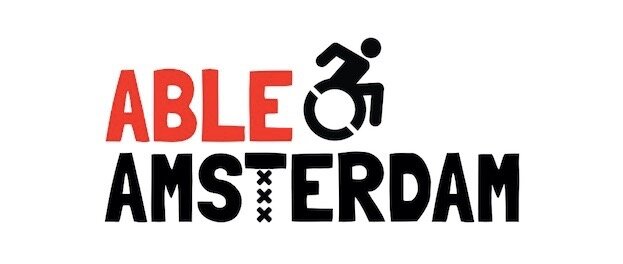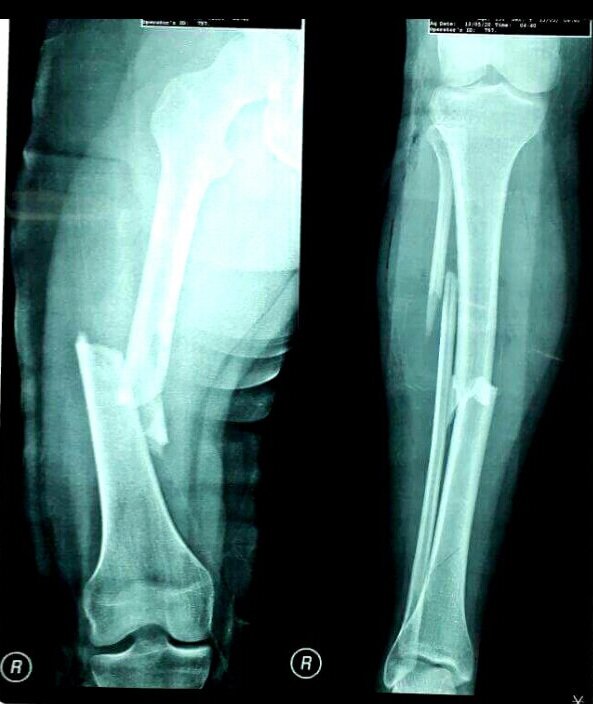10 Tips for femur fracture recovery
May 12th 2017: My femur, tibia and fibula fractures.
The other day I got a phone call from a friend. While cycling in Amsterdam she’d had a nasty accident after the cyclist in front of her stopped suddenly without warning. The resulting collision meant my friend now has a broken femur. “I don’t even know where to start,” she said. “What advice do you have for me? Do you have any tips?“
Three years and 6 surgeries since I shattered my femur, tibia and fibula, it seems I’ve become the go-to person (amongst my friends) for advice about recovering from a broken leg. Please note this is not medical advice — for that you should always seek out the help of a healthcare professional.
Here are my top 10 tips about how to stay as comfortable and stress-free as possible during femur fracture recovery:
1. Reach out to your support network as soon as possible.
If you’ve broken your femur, you will need all the help you can get — especially in the first few weeks. Call your friends or family members as soon as you can to see who can lend a hand.
I also recommend joining the Facebook group Broken Femur Victims Unite, a platform with over 1,000 global members sharing advice and experiences.
2. Look into which relevant services are available in your area.
Mobility equipment rental
Rather than buying brand new mobility aids, it may be more affordable to rent them instead. In the early months of my recovery I rented a wheelchair, a walking frame, and crutches, as well as mobility equipment for in my house.
Home care
This may be useful if you need help showering, getting dressed, or caring for surgical wounds. Inquire with your general practitioner whether these services exist in your area.
Meal delivery services
Cooking can be difficult when you’ve got a broken femur. Check out whether there are any nearby services that deliver ready made meals to your door.
If you’re in the Netherlands, make sure to check out:
Medipoint for mobility aids and equipment rental (wheelchairs, crutches, shower chairs, height-adjustable beds, etc.)
Evean for a range of support like home care and meal delivery services.
Thuiszorg for more information about home care services and district nurse support offered via your municipality.
WMO Helpdesk (in cases of long-term disability) for government-subsidised mobility aids, home care, accessible transport services, and more.
3. Research which specific specialists or hospitals have expertise in treating your type of femur fracture.
Once back in the Netherlands after my accident in Cambodia, I started off getting check-ups with an orthopedic surgeon at my local hospital. After hearing I needed a bone graft due to a non-union fracture, I decided to switch to a different hospital with more expertise in treating cases like mine.
My advice? If you feel the medical expertise is elsewhere, and you have the opportunity to switch, do it. It’s your body, it’s your leg, and you want to make choices that will allow you to maintain and regain as much function as possible.
If you’re in Amsterdam, make sure to check out:
Netwerk Traumarevalidatie for a list of physiotherapists around Amsterdam specialised in physiotherapy for trauma patients. This network is linked to the VUmc hospital.
4. Make temporary accessibility adjustments in your home.
In order to be as independent as possible, you’ll probably need to make some adjustments around the house.
For example: I rented a height-adjustable bed and slept in the living room for over a year until I was able to go upstairs to my bedroom. My mum set up all my clothes on a portable rack downstairs, transforming a back room into a walk-in (roll-in) wardrobe. A helpful carpenter cousin even built a ramp so I could roll in and out of the house independently.
You’ll also want to make sure your bathroom is accessible. I recommend renting/buying the following:
A shower chair
A bath board
A raised toilet seat (with armrests)
A walking frame for extra support
5. A manual wheelchair is a must.
Trust me, you’ll get tired of crutches, blistered hands, and an inability to carry your own cup of tea. Get yourself a manual wheelchair in addition to crutches so you can travel longer distances without feeling too exhausted.
There are a lot of other cool mobility aids and accessories out there. A few of my favourites include:
Aidapt animal print crutches with comfortable soft hand grips
SandPad crutch tips for strolling along the beach
Non-slip crutch tips with extra grip for slippery surfaces
Rollz Motion a wheelchair-and-rollator-in-1
6. Stock up on wide comfy trousers and pyjamas.
All my skinny jeans were banished to my cupboard for the first few months. Thankfully wide-legged trousers have made a comeback, so there is plenty for sale out there combining comfort and fashion.
7. Invest in pillows and a heat pack.
I found it really hard to get comfortable with the pain and discomfort of a shattered leg. I recommend stocking up on pillows — especially a full body pillow — for a good night’s sleep. I’ve also found that a heat pack on my leg helps to reduce the pain.
8. Explore different (stationary) activities to keep yourself busy.
Some ideas include:
Watching all that Netflix has to offer
Learning to play a new instrument
Painting, sewing, knitting, or crocheting
Taking an online course (I got my TEFL certification to teach English as a foreign language).
If you’re looking to stay active while you’re non-weight bearing, I recommend getting a stationary exercise bike.
9. If needed, find someone to talk to about the challenges that come with long-term femur fracture recovery.
Femur fracture recovery can be long, exhausting and emotional. Seek out the help of someone (professional) to talk to if things start to get too difficult or overwhelming.
10. Celebrate the little accomplishments as well as the big ones.
A bit of a cliché, I know — but it’s really helped me to stay motivated.
Even though I still have a long way to go, I remind myself how far I’ve come by documenting the different things I’ve achieved throughout my recovery.
A list I wrote on May 12th, 2018, the first anniversary of my accident.


